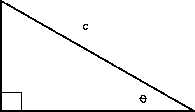TRIGONOMETRIC FUNCTIONS
Trigonometry
TRIGONOMETRIC FUNCTIONS
This chapter covers the six trigonometric functions and solving right triangles.
EO 1.2
Given the following trigonometric terms, IDENTIFY the
related function:
a.
Sine
b.
Cosine
c.
Tangent
d.
Cotangent
e.
Secant
f.
Cosecant
EO 1.3
Given a problem, APPLY the trigonometric functions to
solve for the unknown.
As shown in the previous chapter, the lengths of the sides of right triangles can be solved using
the Pythagorean theorem. We learned that if the lengths of two sides are known, the length of
the third side can then be determined using the Pythagorean theorem. One fact about triangles
is that the sum of the three angles equals 180°. If right triangles have one 90° angle, then the
sum of the other two angles must equal 90°. Understanding this, we can solve for the unknown
angles if we know the length of two sides of a right triangle. This can be done by using the six
trigonometric functions.
In right triangles, the two sides (other than the
Figure 2 Right Triangle
hypotenuse) are referred to as the opposite and adjacent
sides. In Figure 2, side a is the opposite side of the
angle q and side b is the adjacent side of the angle q.
The terms hypotenuse, opposite side, and adjacent side
are used to distinguish the relationship between an acute
angle of a right triangle and its sides. This relationship
is given by the six trigonometric functions listed below:
(4-2)
sine q
a
c
opposite
hypotenuse
(4-3)
cosine q
b
c
adjacent
hypotenuse
MA-04
Page 4
Rev. 0


